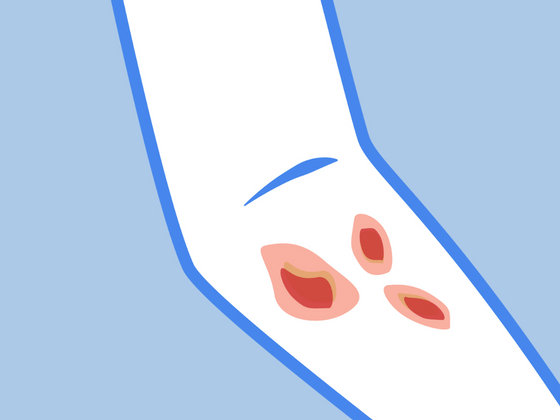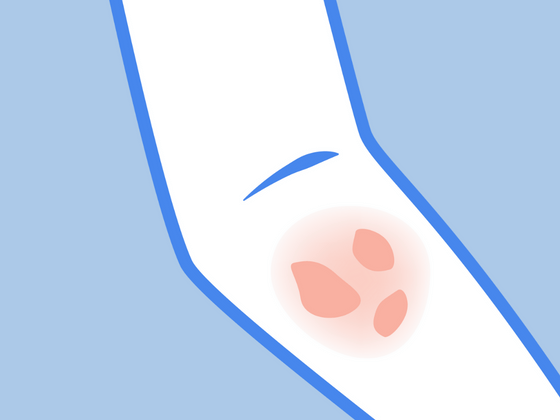Eczema can make skin red, dry, itchy, weeping/oozing, thick, scaly or any combination of those symptoms. It often develops in problem spots where skin touches skin, like eczema behind the knees. Sweat and salt can build up and cause irritation and chafing is a big concern as well. Itchy skin leads to scratching which makes the skin even redder and itchier and thus you have a vicious circle, the itch-scratch cycle.
Common symptoms of eczema on the knees are:
- Red scaly patches or sections that look lighter or darker on people with dark skin.
- Small rough bumps that may leak fluid and crust over.
- Red, inflamed skin that resembles sunburn of varying intensities.
Unfortunately, eczema on the back of the knees can cause discomfort whenever the leg bends during walking, running, or playing. It can cause a distraction during the day or a problem at night going to sleep. Knee eczema can be especially problematic if the area gets dry and cracked, because bacteria can enter through the broken skin and cause infections.
How to Treat Eczema on Knees
1.Moisturize
Eczema behind the knees is often treated with an emollient, such as Organic Manuka Skin Soothing Cream or a beef tallow cream, that when applied to inflamed skin, forms a protective film to keep in the skin's natural moisture. This cream also offers additional hydration and wound healing due to the Manuka honey and Manuka oil it contains. Emollients such as this can be applied twice daily and should always be used after a lukewarm shower or bath.
You can find an emollient and treatment designed for your specific type of eczema symptoms. What does your eczema look like? Select from the categories below:
Red, Weeping Eczema – the skin looks angry and very irritated, may be weeping or oozing and could develop a crust. This is often how the skin looks during topical steroid withdrawal (TSW).
Itchy, Red, Dry Eczema – the skin is mostly itchy, with some dryness and redness.
Thick, Scaly Eczema – the skin has thickened and developed a scaly appearance like that of a crocodile. This is more common in chronic cases.
2.Wet Wrap Therapy
A simple but effective way to allow emollients to work better without the need for corticosteroids, is to use wet wrap therapy or dry wrap therapy. These types of treatment allows emollients to work longer and more efficiently.
Dry wrapping is a good first step as it's easier and less messy than wet wrapping. To make things really easy and effective, try Remedywear™ clothing for eczema, which is designed to wear dry, no need for wet wrapping. It's made from TENCEL with zinc embedded in the clothing, all very therapeutic and great for eczema. They make an eczema bandage that works very well for knee eczema. With any of these garments, simply apply a good emollient and then wear them over the areas needing treatment.
If you're up for trying wet wrap therapy for knee eczema, using these special treatment wraps is fast and easy. Wet wrapping works by exposing the skin to constant moisture for an extended period of time, essentially locking in the moisture to provide instant relief. Studies report a dramatic reduction of eczema symptoms within five days of beginning wet wrap treatment.
To begin wet wrap therapy:
- Take a bath with lukewarm water.
- Pat the skin dry with a clean towel.
- Apply an emollient like this one.
- For wet wrap therapy, wet the band/sleeve in warm water, gently wring out, and slip around the knee, then cover with a dry layer of clothing or another band/sleeve. For dry wrap therapy, simply apply the sleeve over the knee and you're done.
- Remove the band/sleeve two hours later or the next morning, if using overnight, and apply another layer of emollient.
3.Determine Triggers
Things our bodies come in contact with can cause eczema to flare. These “triggers” vary from person to person and can include:
- Airborne allergens like pollen, dust, grass, or pet dander
- Food like dairy, eggs, gluten, and acidic food like tomatoes
- Fabric or chemical irritants like detergent for sensitive skin, eczema soap, or nickel jewelry
- Oral and topical medications like antibiotics, steroids, and birth control
- Stress
The most important step to improving eczema is to find and eliminate triggers. Try keeping a journal to discover what may be causing flare-ups—something you ate or wore, going outside, or feeling stressed.
4.Heal from Within
For more stubborn eczema and chronic cases that just keep coming back, it’s best to look at the full picture – your body as a whole. Many times eczema is an outward expression of something going on within your body that needs to be addressed.
Learn more about anti-inflammatory diets and other tips to heal from within here.
References
https://www.nhs.uk/conditions/atopic-eczema/symptoms/
https://skinanswer.com/eczema-on-back-of-knees-diagnosis-symptoms-and-treatments/
https://www.hindawi.com/journals/isrn/2014/354250/
------------------

Bio: Laura is a contributor and content developer for The Eczema Company. She is in no way a medical professional. Her comments, suggestions, and reflections are not intended to replace any medical advice. Always seek the help of a medical professional before undertaking any diet or lifestyle changes.







